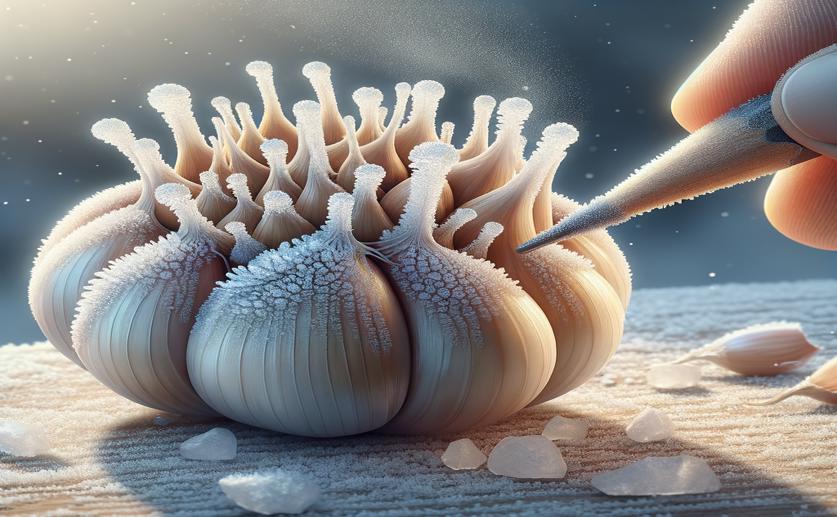How Frostbite Starts on Tiny Natural Crystals in Garlic Cloves

Image Source: Natural Science News, 2024
Key Findings
- Researchers from the Tokyo Institute of Technology found that magnetite nanocrystals in garlic cloves can trigger ice formation
- Weak oscillating magnetic fields increased the likelihood of freezing, while stronger fields decreased it, showing that magnetite's ice-nucleating ability can be controlled
- The study suggests that magnetite binding agents, loosely attached to the crystals, influence their effectiveness in ice nucleation
Understanding how ice forms in supercooled water is crucial for various scientific and practical applications, from predicting weather patterns to improving cryopreservation techniques. Recent research from the Tokyo Institute of Technology has shed new light on this process by investigating the role of biologically precipitated magnetite (Fe3O4) nanocrystals in plants, specifically in garlic cloves, and their influence on ice nucleation[1].
Ice nucleation is the process by which ice crystals form from supercooled water. Supercooled water is liquid water cooled below its normal freezing point without turning into ice. This state is unstable, and ice nucleation can be triggered by various particles known as ice nucleation particles (INPs). Previous studies have identified several types of INPs, including biological ice nuclei like the bacterium Pseudomonas syringae, which can reduce supercooling and enhance ice crystal formation[2]. Mineral dust, particularly feldspar, has also been identified as a significant INP in mixed-phase clouds, influencing cloud properties and weather patterns[3].
In the current study, researchers aimed to explore whether magnetite nanocrystals present in plant tissues could serve as INPs and contribute to frost damage in plants. Using superconducting magnetometry, a highly sensitive technique for measuring magnetic properties, they detected significant amounts of magnetite INPs within individual garlic cloves. This detection was crucial as it provided direct evidence of the presence of magnetite nanocrystals in plant tissues.
To further understand the role of these magnetite nanocrystals in ice nucleation, the researchers subjected the garlic cloves to oscillating magnetic fields. These fields were designed to torque, or twist, the magnetite crystals in situ, thereby disturbing the ice nucleating process. The results were telling: the oscillating magnetic fields significantly affected the temperature distribution of supercooling in the garlic cloves. Specifically, weak oscillating fields increased the probability of freezing, while stronger fields decreased it. This outcome suggests that magnetite crystals act as INPs in vivo and that their ice nucleating ability can be modulated by external magnetic fields.
Interestingly, the study also proposed the presence of magnetite binding agents. These agents appear to be loosely attached to the ice nucleating sites on the magnetite crystals, influencing their effectiveness as INPs. This finding is significant because it hints at a more complex mechanism of ice nucleation involving not just the magnetite crystals but also their interactions with other biological molecules.
The discovery of magnetite's role in ice nucleation in plants builds on earlier findings about the mechanisms of ice formation in supercooled water. For instance, it has been known that the crystallization rate of water reaches a maximum around 225 K, below which ice nuclei form faster than liquid water can equilibrate[4]. This new study adds another layer of understanding by identifying a specific type of INP within plant tissues that can influence this process.
Moreover, the study's findings have practical implications. Understanding how magnetite nanocrystals contribute to frost damage in plants could lead to new strategies for enhancing frost resistance in crops. Additionally, the ability to modulate ice nucleation using magnetic fields opens up potential applications in cryopreservation and other technologies where controlled ice formation is crucial.
In summary, the research from the Tokyo Institute of Technology provides compelling evidence that biologically precipitated magnetite nanocrystals in plants can act as powerful INPs, influencing the supercooling and freezing processes. This discovery not only advances our understanding of ice nucleation in biological systems but also offers new avenues for practical applications in agriculture and technology.
MedicineBiochemPlant Science
References
Main Study
1) Biophysical evidence that frostbite is triggered on nanocrystals of biogenic magnetite in garlic cloves (Allium sativum).
Published 18th September, 2024
Journal: Communications biology
Issue: Vol 7, Issue 1, Sep 2024
Related Studies
2) Ice crystallization by Pseudomonas syringae.
Journal: Applied microbiology and biotechnology, Issue: Vol 54, Issue 2, Aug 2000
Related Articles





 28th August, 2024 | Jim Crocker
28th August, 2024 | Jim Crocker